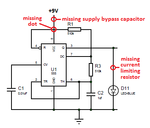D.A.(Tony)Stewart
Advanced Member level 7

- Joined
- Sep 26, 2007
- Messages
- 10,251
- Helped
- 1,866
- Reputation
- 3,737
- Reaction score
- 2,505
- Trophy points
- 1,413
- Location
- Richmond Hill, ON, Canada
- Activity points
- 64,681
If you get a batch of LED's and test them with a 9V battery and choose the R for the desired current 1mA ( 6k) or 2 mA (3k), or 10mA (600R) or 20mA (300R) whatever and then sort the Vf in increment bins
My batches come in within +/-0.1V All that matters is the total strings addup to match. The Vf at low currents are all the same for the same colour wavelength . The variation is the ESR which is ~15 Ohms or so.
My batches come in within +/-0.1V All that matters is the total strings addup to match. The Vf at low currents are all the same for the same colour wavelength . The variation is the ESR which is ~15 Ohms or so.









